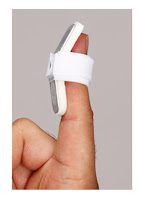There are several treatment options for mallet finger.Splinting is the most common initial treatment method for soft tissue or bony mallet finger. Regardless of the treatment option, common sequelae include a slight extensor lag and a prominent bump on the dorsum of the finger.Many splint configurations and surgical techniques have been described over the past several decades. However, the optimal treatment of each type of mallet finger injury remains controversial.
 |
| Our Price : Rs 61 |
An excellent outcome is no pain with full range of motion at the DIP joint, less than 10-degree extension deficit is a good outcome, 10–25 degrees of extension deficit with no pain is a fair outcome, and more than 25 degrees of extension deficit or persistent pain is considered a poor outcome. A Mallet Finger treatment outcome assessment classification was proposed by Crawford. It is the most commonly used classification for outcome assessment after mallet finger.
Makhlouf and Deek have considered surgery when splinting cannot correct acute deformities; however, we will review the present literature for acute open and chronic deformities. Most surgeons believe closed/non-operative treatment using splints produces satisfactory results for tendon avulsions without fracture and minimally displaced or small fractures.
Mallet Finger
The authors feel non-operative management of mallet finger is indicated in cases of all soft tissue mallets and bony mallets which are well reduced in a splint without DIP joint subluxation. Immobilization of both the PIP and DIP joints was previously thought to be necessary to relax the extensor hood and intrinsic musculature during terminal extensor tendon healing.
Whether PIP joint motion would cause a tendon gap at the immobilized DIP joint. They demonstrated that gapping of a disrupted terminal extensor tendon occurred as a result of excursion of the distal tendon stump during DIP joint flexion, not because of retraction of the proximal portion of the tendon with simulated PIP joint extension. They concluded that only the DIP joint need be immobilized in extension to allow healing of the mallet injury. Most authors currently advocate immobilization of the DIP joint alone
Splinting
There are many variations in the design of splints, but the principle is the same. All Frog Splint Mallet Finger are designed to maintain full extension or slight hyper extension at the DIP joint. Commonly used splints are plastic stack splints, thermoplastic, and aluminum form splints. The authors recommend full time splinting for 6 weeks, followed by 2–6 weeks of splinting at night. The splint should be used continuously and the DIP joint should be maintained in full extension even during skin hygiene care.
Patients should be instructed on how to change the splint for periodic cleaning and examination of the skin without allowing the DIP joint to flex. Neglecting a mallet injury or incorrect treatment can lead to DIP joint dysfunction. 1 mm lengthening of the terminal extensor tendon results in 25 degrees of extension lag, and a shortening of 1 mm will seriously restrict DIP joint flexion.
 |
| Our Price : Rs 79 |
Patients should be instructed on how to change the splint for periodic cleaning and examination of the skin without allowing the DIP joint to flex. Neglecting a mallet injury or incorrect treatment can lead to DIP joint dysfunction. 1 mm lengthening of the terminal extensor tendon results in 25 degrees of extension lag, and a shortening of 1 mm will seriously restrict DIP joint flexion.
There are several studies comparing mallet finger splints. Perforated splints are better tolerated than solid stack splints. Aluminum-alloy malleable splints are associated with more skin complications as compared with the stack splint, but final outcomes are similar. Warren compared the use of the Abouna splint (rubber coated wire splint) versus the stack splint in a randomized study involving 116 patients.
The Abouna splint had skin complications and poorer patient satisfaction but similar final outcomes as compared with the stack splint. Pike et al. compared the clinical and radiographic extensor lag measurements for mallet fingers treated with volar, dorsal, and custom thermoplastic splinting. There was no extensor lag difference between splints at 12-week follow-up and increased extensor lag was noted with all three splints after discontinuation at 6 weeks of time.
The Abouna splint had skin complications and poorer patient satisfaction but similar final outcomes as compared with the stack splint. Pike et al. compared the clinical and radiographic extensor lag measurements for mallet fingers treated with volar, dorsal, and custom thermoplastic splinting. There was no extensor lag difference between splints at 12-week follow-up and increased extensor lag was noted with all three splints after discontinuation at 6 weeks of time.

















